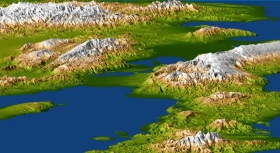Published January 13, 2010 06:56 AM
Magnitude 7.0 Earthquake Hits Haiti

The earthquake that has hit Haiti, raising fears that thousands have
been killed, is the latest in a long line of natural disasters to befall
a country ill equipped to deal with such events.
Hurricanes and flooding are perennial concerns for the poorest country
in the western hemisphere, which has time and again been dependent on
foreign aid in emergencies.
In 1963 hurricane Flora, the sixth deadliest Atlantic hurricane in
history, devastated the island. The US weather bureau estimated the
death toll at 5,000 and the cost of damage to property and crops at
between $125m and $180m.
The country was struck by two disasters in 2004. In May heavy rains caused flooding that killed more than 2,000 people. Four months later mudslides and flooding caused by hurricane Jeanne, the 12th deadliest Atlantic hurricane, killed more than 3,000 people, mostly in the town of Gonaives.
Tragedy struck again in 2008 when four storms — tropical storm Fay, hurricane Gustav, hurricane Hanna and hurricane Ike — dumped heavy rains on the country. Around 1,000 people died and 800,000 were left homeless. The number of people affected by the storms was put at 800,000 — almost 10% of the population — with the damage estimated at $1bn.
The January 12, 2010, Haiti earthquake occurred in the boundary region separating the Caribbean plate and the North America plate. This plate boundary is dominated by left-lateral strike slip motion and compression, and accommodates about 20 mm/y slip, with the Caribbean plate moving eastward with respect to the North America plate.
Haiti occupies the western part of the island of Hispaniola, one of the Greater Antilles islands, situated between Puerto Rico and Cuba. At the longitude of the January 12 earthquake, motion between the Caribbean and North American plates is partitioned between two major east-west trending, strike-slip fault systems -- the Septentrional fault system in northern Haiti and the Enriquillo-Plaintain Garden fault system in southern Haiti.
The location and focal mechanism of the earthquake are consistent with the event having occurred as left-lateral strike slip faulting on the Enriquillo-Plaintain Garden fault system. This fault system accommodates about 7 mm/y, nearly half the overall motion between the Caribbean plate and North America plate.
The Enriquillo-Plaintain Garden fault system has not produced a major earthquake in recent decades. The EPGFZ is the likely source of historical large earthquakes in 1860, 1770, 1761, 1751, 1684, 1673, and 1618, though none of these has been confirmed in the field as associated with this fault.
For more information: Guardian UK: http://www.guardian.co.uk/world/2010/jan/13/haiti-earthquake-history-disasters
USGS: http://earthquake.usgs.gov/earthquakes/recenteqsww/Quakes/us2010rja6.php#maps
2009. Copyright Environmental News Network To subscribe or visit go to: http://www.enn.com